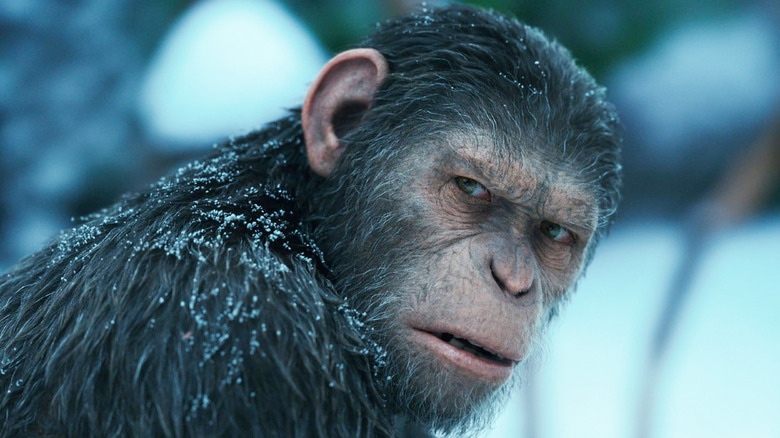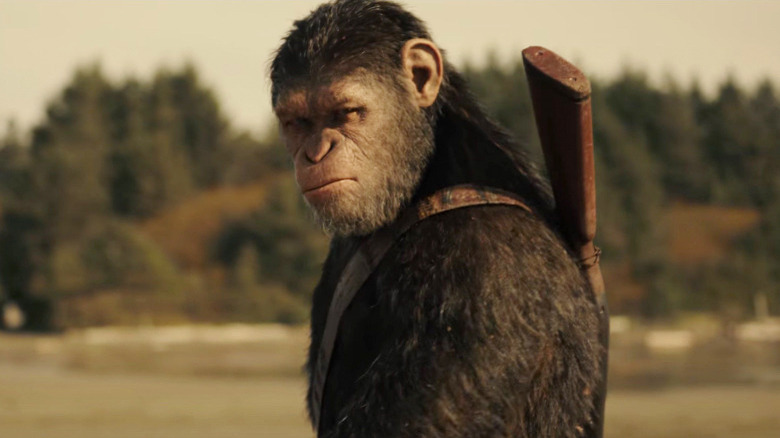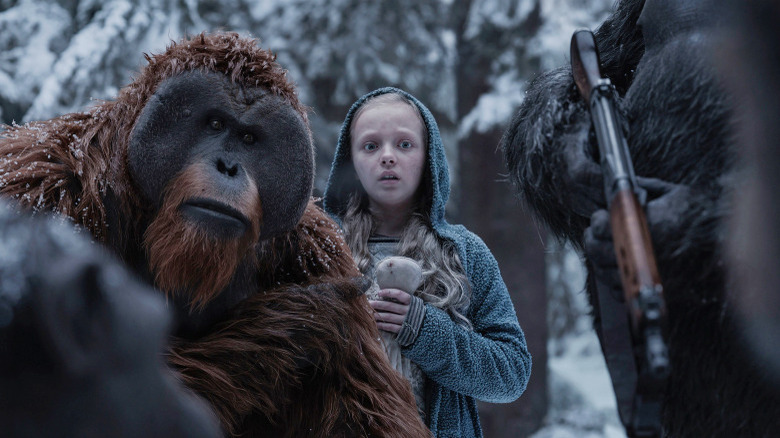Matt Reeves Borrowed From A Western Master While Making War For The Planet Of The Apes
There's a reason Matt Reeves' "War for the Planet of the Apes" is listed by critics alongside "Mad Max: Fury Road" and "Logan" as one of the most significant big-budget franchise movies of the 2010s. Unlike 2014's "Dawn of the Planet of the Apes," where he replaced "Rise of the Planet of the Apes" director Rupert Wyatt a year into pre-production, Reeves was involved with "War" from the very start. This allowed him to imbue the film with a mythic quality that is missing from "Dawn" (which is still a damn dirty fine "Apes" movie in its own right).
Where Reeves' films "Cloverfield" (a post-9/11 kaiju movie) and "Let Me In" (a vampire drama about Reagan's America) look to the past, "Dawn of the Planet of the Apes" is eerily prescient in the way it depicts a world thrown into chaos by a pandemic. "War for the Planet of the Apes" similarly pits the apes and their leader Caesar (Andy Serkis) against Woody Harrelson's "The Colonel," a zealous military man whose slogan might as well be "Make Earth Great Again," to quote The Hollywood Reporter. Reeves insisted the parallels to a certain ex-president were "totally unintentional" when the film arrived in 2017 but admitted it was "weirdly resonant of the moment."
In order to give "War" an expanded visual style befitting its dark, apocalyptic story, Reeves shot the movie using the Alexa 65 large format camera rig. The film got its working title, "Hidden Fortress," from the 1958 adventure movie directed by Akira Kurosawa, whose action films have been cited by Reeves as a key influence on "War." More than any other director, however, Reeves said he looked to the work of western expert Sergio Leone for inspiration.
An epic yet intimate blockbuster
Speaking to Den of Geek in July 2017, Matt Reeves explained why he and "Dawn of the Planet of the Apes" cinematographer Michael Seresin (whose other notable works include "Angela's Ashes" and "Harry Potter and the Prisoner of Azkaban") took a different approach to shooting "War for the Planet of the Apes:"
"There are a couple of reasons for that. One is that I shot on a new system – we shot on an Alexa 65. I wanted the movie to be, like, a widescreen movie like a David Lean movie, or a [Sergio] Leone movie, and see the apes against the landscape of the planet. What I've been excited about from the beginning was the idea of taking cutting edge technology and mirroring that with traditional forms, with the idea of myth, and a really classical story. So you'd have this odd experience of seeing something that felt very rooted, a kind of timeless story, and yet the uncanny aspect of there being these apes that are playing out that drama. And so on this one, I wanted it to be a very epic-scale movie, but still very intimate."
Different camera lenses can dramatically change the way a location looks and feels on-screen (a trick Sidney Lumet made powerful use of in his classic single-room courtroom drama "12 Angry Men"). In the case of the "adapted Hasselblad lenses" of the Alexa 65 system, Reeves explained, it became possible for him and Seresin to create "beautiful detailed vistas" for "War." But more than that, the system allowed them to capture portrait-like closeups of both the movie's humans and CGI apes:
"That was what I was excited about – somehow we could do the epic, but also the intimate. Visually, that gave us a different look."
Once upon a time in the Ape-West
Few directors excel at marrying extreme closeups with sweeping vistas like Sergio Leone, the Italian director of the famous 1960s Dollars trilogy ("A Fistful of Dollars," "For a Few Dollars More, "The Good, the Bad and the Ugly"). His Spaghetti Westerns have gone on to shape everything from Quentin Tarantino's films to "Star Wars" and were even recently homaged in David Jenkins' pirate comedy series "Our Flag Means Death." Matt Reeves similarly looked to Leone to help create the grandiose yet personal visual style he wanted for "War for the Planet of the Apes."
"I wanted to push the final chapter of Caesar's story into the realm of the mythic, so it almost becomes like this Darwinian biblical epic," Reeves told the Los Angeles Times in November 2017. As such, he studied Akira Kurosawa's action movies heavily prior to filming, along with David Lean epics like "The Bridge on the River Kwai" and "Lawrence of Arabia." But more than his Dollars trilogy, Reeves said he took a lot from Leone's 1968 western "Once Upon a Time in the West:"
"I was very affected by the way Sergio Leone alternated wide shots with these super-tight close-ups. I wanted to make 'War' more classical, almost like a western. On one level, the spectacle has to do with seeing our characters being dwarfed by the landscape, which I find very moving."
His approach was effective, too. "War" has the appropriate scale and scope for a gloomy blockbuster where humans are portrayed as the antagonists in a battle to reclaim the planet, yet it never loses sight of Caesar's internal journey and personal sacrifices. As Caesar himself might put it, "Apes together [with some classic-style filmmaking] strong."


